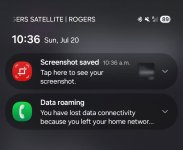Relax
Well-known member
If I'm reading this right, no more need for a separate dedicated satellite communicator (Garmin InReach, etc.) while traveling in remote areas? Not sure where the 5.4 million square kilometers covers, though.

 www.rcrwireless.com
www.rcrwireless.com
Canada’s first sat-to-phone service – Rogers becomes the first Canadian carrier to offer satellite-to-mobile messaging, dramatically expanding coverage to over 5.4 million sq. km.
Free beta – The Rogers Satellite beta is free for all users through October and will support text, text-to-911 and eventually voice and data.
Connectivity where it matters – The service is seen as a public safety boost, enabling communications in regions previously unreachable by traditional networks.
Canadian telco Rogers Communications has launched a beta version of Rogers Satellite, a new satellite-to-mobile text messaging service, making it the first wireless provider in the country to offer direct satellite connectivity to mobile phones.
In a release, the telco noted that the new offering extends wireless coverage to over 5.4 million square kilometers.
The telco explained that the technology automatically connects users’ phones to a satellite signal in areas without cellular coverage, enabling text messaging and access to emergency services such as text-to-911. It uses Rogers’ national wireless spectrum combined with low-Earth orbit (LEO) satellite connectivity, making it compatible with most modern smartphones.
Tony Staffieri, president and CEO of Rogers, said: “We’re proud to introduce this ground-breaking technology to help Canadians stay safe and connected in more places. This next-generation service marks another major milestone in wireless connectivity.”
The telco launched the Rogers Satellite beta program at no cost. During the beta phase, users will be able to send text messages and access text-to-911 services. Voice and data capabilities — including 911 voice support — are expected to roll out later.
Once the beta concludes in October, the service will be bundled at no additional charge for customers on Rogers’ Ultimate Plan, or available to others for CAD15 ($11) per month.
The telco also noted that only about 18% of the country’s territory is covered by traditional wireless networks. With the new satellite service, users will be able to stay connected in remote locations like the Rocky Mountains, northern Quebec and the southern coasts of Hudson Bay.
Mark Kennedy, chief technology officer at Rogers, added: “Now, with Rogers mobile spectrum paired with satellite technology, Canadians can turn their smartphone into a satellite phone. This allows access to text-to-911 and basic connectivity in some of the country’s most remote areas.”
The service is accessible in outdoor areas with a clear view of the sky, including over water. The company said testing and optimization will continue throughout the trial.
Earlier this year, Rogers Communications started to deploy Ericsson 5G Advanced (5G-A) technology on its national network, claiming to be the first carrier in Canada to launch such technology. Rogers is rolling out Ericsson’s 5G Advanced RedCap software to power IoT devices, such as sensors, cameras and monitoring equipment. This technology enables the telco to use network resources more efficiently, while it supports longer battery life for wearables.
In February 2024, Rogers Communications said it had successfully tested 5G network slicing technology, stating that it was the first nationwide live test of this technology in Canada.
The operator tested 5G network slicing technology in Toronto, Montreal and Vancouver in partnership with Ericsson on the company’s 5G SA network.
Rogers said it will use network slicing technology this year to offer a dedicated network slice for first responders to have priority on the network. The company will also use this technology to separate fixed and mobile traffic on its national 5G network and accelerate the expansion of 5G wireless home internet to more rural and remote communities across Canada, which will enable the telco to optimize and dedicate traffic flows to ensure a more reliable service for both residential and mobile users.

Rogers launches satellite-to-mobile service for 911 text, voice support
Rogers noted that the new offering extends wireless coverage to over 5.4 million square kilometers.
Rogers explained that the technology automatically connects users’ phones to a satellite signal in areas without cellular coverage
In sum – what to know:Canada’s first sat-to-phone service – Rogers becomes the first Canadian carrier to offer satellite-to-mobile messaging, dramatically expanding coverage to over 5.4 million sq. km.
Free beta – The Rogers Satellite beta is free for all users through October and will support text, text-to-911 and eventually voice and data.
Connectivity where it matters – The service is seen as a public safety boost, enabling communications in regions previously unreachable by traditional networks.
Canadian telco Rogers Communications has launched a beta version of Rogers Satellite, a new satellite-to-mobile text messaging service, making it the first wireless provider in the country to offer direct satellite connectivity to mobile phones.
In a release, the telco noted that the new offering extends wireless coverage to over 5.4 million square kilometers.
The telco explained that the technology automatically connects users’ phones to a satellite signal in areas without cellular coverage, enabling text messaging and access to emergency services such as text-to-911. It uses Rogers’ national wireless spectrum combined with low-Earth orbit (LEO) satellite connectivity, making it compatible with most modern smartphones.
Tony Staffieri, president and CEO of Rogers, said: “We’re proud to introduce this ground-breaking technology to help Canadians stay safe and connected in more places. This next-generation service marks another major milestone in wireless connectivity.”
The telco launched the Rogers Satellite beta program at no cost. During the beta phase, users will be able to send text messages and access text-to-911 services. Voice and data capabilities — including 911 voice support — are expected to roll out later.
Once the beta concludes in October, the service will be bundled at no additional charge for customers on Rogers’ Ultimate Plan, or available to others for CAD15 ($11) per month.
The telco also noted that only about 18% of the country’s territory is covered by traditional wireless networks. With the new satellite service, users will be able to stay connected in remote locations like the Rocky Mountains, northern Quebec and the southern coasts of Hudson Bay.
Mark Kennedy, chief technology officer at Rogers, added: “Now, with Rogers mobile spectrum paired with satellite technology, Canadians can turn their smartphone into a satellite phone. This allows access to text-to-911 and basic connectivity in some of the country’s most remote areas.”
The service is accessible in outdoor areas with a clear view of the sky, including over water. The company said testing and optimization will continue throughout the trial.
Earlier this year, Rogers Communications started to deploy Ericsson 5G Advanced (5G-A) technology on its national network, claiming to be the first carrier in Canada to launch such technology. Rogers is rolling out Ericsson’s 5G Advanced RedCap software to power IoT devices, such as sensors, cameras and monitoring equipment. This technology enables the telco to use network resources more efficiently, while it supports longer battery life for wearables.
In February 2024, Rogers Communications said it had successfully tested 5G network slicing technology, stating that it was the first nationwide live test of this technology in Canada.
The operator tested 5G network slicing technology in Toronto, Montreal and Vancouver in partnership with Ericsson on the company’s 5G SA network.
Rogers said it will use network slicing technology this year to offer a dedicated network slice for first responders to have priority on the network. The company will also use this technology to separate fixed and mobile traffic on its national 5G network and accelerate the expansion of 5G wireless home internet to more rural and remote communities across Canada, which will enable the telco to optimize and dedicate traffic flows to ensure a more reliable service for both residential and mobile users.
















